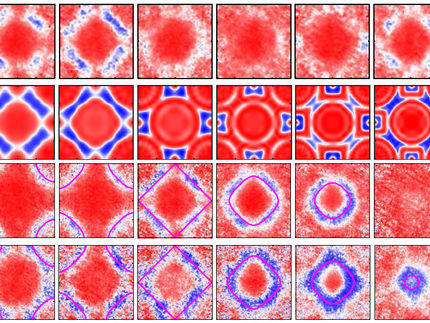New topological metamaterial amplifies sound waves exponentially
Advertisement
Researchers at AMOLF, in collaboration with partners from Germany, Switzerland, and Austria, have realized a new type of metamaterial through which sound waves flow in an unprecedented fashion. It provides a novel form of amplification of mechanical vibrations, which has the potential to improve sensor technology and information processing devices. This metamaterial is the first instance of a so-called ‘bosonic Kitaev chain’, which gets its special properties from its nature as a topological material. It was realized by making nanomechanical resonators interact with laser light through radiation pressure forces.

Ella Maru Studio
The discovery, which was recently published in the renowned scientific journal Nature, was achieved in an international collaboration between AMOLF, the Max Planck Institute for the Science of Light, the University of Basel, ETH Zurich, and the University of Vienna.
The ‘Kitaev chain’ is a theoretical model that describes the physics of electrons in a superconducting material, specifically a nanowire. The model is famous for predicting the existence of special excitations at the ends of such a nanowire: Majorana zero modes. These have gained intense interest because of their possible use in quantum computers. AMOLF group leader Ewold Verhagen: “we were interested in a model that looks mathematically identical, but describes waves like light or sound, instead of electrons. Since such waves consist of bosons (photons or phonons) rather than fermions (electrons), their behavior is expected to be very different. Nonetheless, in 2018 it was predicted that a bosonic Kitaev chain exhibits fascinating behavior that is not known of any natural material, nor of any metamaterial to date. While many scientists were interested, experimental realization remained elusive.”
Optical springs
The bosonic Kitaev chain is essentially a chain of coupled resonators. It is a metamaterial, i.e., a synthetic material with engineered properties: the resonators can be thought of as the ‘atoms’ of a material, and the way they are coupled together controls the collective metamaterial behavior; in this case the propagation of sound waves along the chain. “The couplings – the links of the bosonic Kitaev chain – need to be special, and can’t be made with regular springs, for example,” says first author of the Nature paper Jesse Slim, who graduated cum laude last year. “We realized that we could experimentally create the required links between nanomechanical resonators – small vibrating silicon strings on a chip – by coupling them with the help of forces exerted by light; thus creating ‘optical’ springs. Carefully varying the intensity of a laser over time then allowed linking five resonators and implementing the bosonic Kitaev chain.”
Exponential amplification
The result was striking. “The optical coupling mathematically resembles the superconducting links in the fermionic Kitaev chain,” says Verhagen. “But uncharged bosons do not exhibit superconductivity; instead, optical coupling adds amplification to the nanomechanical vibrations. As a result, sound waves, which are the mechanical vibrations propagating through the array, are exponentially amplified from one end to the other. Interestingly, in the opposite direction transmission of vibrations is forbidden. And even more intriguing, if the wave is delayed a bit – by a quarter of an oscillation period – the behavior is completely inverted: the signal is amplified backwards and blocked forwards. The bosonic Kitaev chain thus acts like a unique type of directional amplifier, which could have interesting applications for signal manipulation, in particular in quantum technology.”
Topological metamaterial
The interesting properties of Majorana zero modes in the electronic Kitaev chain are linked to the fact that the material is topological. In topological materials, certain phenomena are invariably connected to the general mathematical description of the material. Those phenomena are then topologically protected, meaning that they are guaranteed to exist, even if the material suffers from defects and perturbations. The understanding of topological materials was awarded the Nobel prize of physics in 2016, but this encompassed only materials that do not feature amplification or damping. The description of topological phases that do include amplification is still a topic of intense research and debate.
Together with theory collaborators Clara Wanjura (Max Planck Institute for the Science of Light), Matteo Brunelli (University of Basel), Javier del Pino (ETH Zurich), and Andreas Nunnenkamp (University of Vienna), the AMOLF researchers showed that the bosonic Kitaev chain is in fact a new topological phase of matter. The observed directional amplification is a topological phenomenon associated with this phase of matter, as the theory collaborators predicted in 2020. They demonstrated a unique experimental signature of the topological nature of the metamaterial: if the chain is closed, such that it forms a ‘necklace’, amplified sound waves in the ring of resonators keep circulating and reach a very high intensity, similar to how strong light beams are generated in lasers.




























































